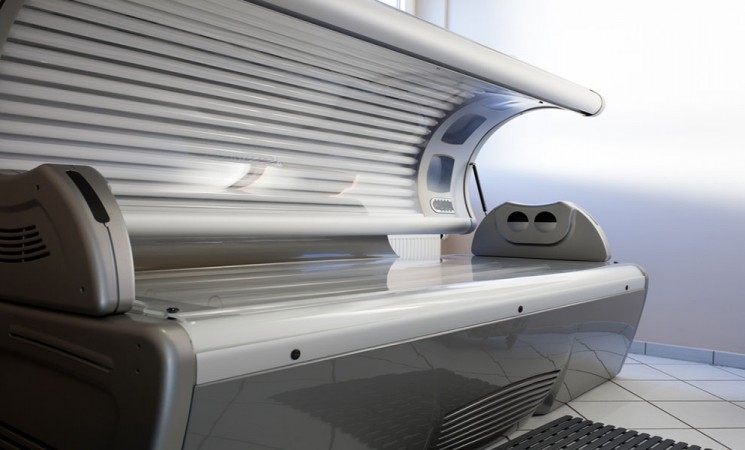Archived Content
This page is archived and provided for historical reference. The content is no longer being updated, and some of the information may have changed over time and could be outdated or inaccurate.

By Wendy Anson, Ph.D.
Are young women who are exposed to web-based anti-tanning interventions more or less likely to expose themselves to the harmful UVA rays found in tanning beds?
Indoor tanning beds emitting artificial ultraviolet (UV) radiation are implicated in approximately 450,000 cases of non-melanoma skin cancer and 11,300 cases of melanoma each year in the United States, northern and western Europe, and Australia (Wehner et al., 2012). Just a few years ago, nearly one in three young adult American women reported using indoor tanning beds in the past year (Guy, Berkowitz, Watson, Holman, & Richardson, 2013). Disconcertingly, an increase in melanoma incidence was reported in this same group over the past two decades (Coelho & Hearing, 2010).
The special issue of the APA’s Society for Health Psychology journal, Health Psychology: eHealth/mHealth, funded by the NIH Office of Behavior and Social Sciences Research (OBSSR), outlined a study motivated in part by the “dark side” of the indoor tanning phenomenon. The 2014 “Surgeon General’s Call to Action to prevent Skin Cancer” signaled the need for innovative indoor tanning behavioral interventions, aligning tanning bed motivation with “the desire to look attractive and healthy and to conform to societal beauty standards” (U.S. Department of Health and Human Services, 2014, p.27).
Stapleton and his colleagues’ based their study in part on body image theory, which is the notion that one’s thoughts and actions related to one’s appearance are influenced by his or her perceptions of societal beauty standard or ideals (Stice, 2001; Thompson & Stice, 2001). The researchers posited that a young woman’s societal experiences could lead her to form a “tan beauty ideal”; that is, she would desire the same tan as her favorite celebrities and likewise would measure and compare her tan with the ideal tan level (Cafri et al., 2008; Gillen & Markey, 2012; Prichard, Kneebone, Hutchinson , & Wilson, 2014).
#eHealth tanning intervention exposes young women to the dark side of #UV rays
Participants were women between the ages of 18 and 25 who had used indoor tanning beds in the past 12 months. The researchers recruited participants from a U.S. northeastern university.
In the two-arm randomized controlled trial, participants were randomized to the intervention condition or to a wait-list control condition. The intervention guided participants through internet material in a predetermined order. Each “page” contained thought exercises with corresponding closed- or open-ended responses.
The participants answered questions related to how media figures influence their own indoor tanning habits, how they reacted to an unaltered celebrity image as compared with the altered image of the celebrity, and their thoughts upon viewing evidence of how salon advertising creates digitally enhanced “perfect” tans versus actual tans. One key question asked the women about the role their indoor tanning played in any negative moods resulting from body dissatisfaction.
Can young women show #behaviorchange when exposed to evidence of #tanningbed #UV damage?
To re-structure tanning-related beliefs, researchers presented counter perspectives to the tan ideal, including educational components about the potentially negative aspects of tanning, such as premature skin aging and skin wrinkling. Uniquely, the Stapleton study used the web-based format in addition to thought exercises to target central body image constructs.
Following the intervention, participants reported an average of 2.54 indoor tanning sessions (SD = 6.39) during the six-week follow-up period compared to controls, who reported 4.02 indoor tanning sessions (SD = 4.02). Those who participated in the intervention also reported a significantly lower mean likelihood of future use of indoor tanning (M= 2.15, SD = 1.47) compared with control participants (M = 1.50, SD = 1.30).
Stapleton theorized that the adaptation of the intervention to a more traditional web format with the addition of interactive components and social media could engage participants to a greater degree.
Read the Article
Related Reads
A Pilot Randomized, Controlled Trial of an Active Video Game Physical Activity Intervention
About the Author
 Wendy Anson, Ph.D.
Wendy Anson, Ph.D.
Wendy Anson, Ph.D., is senior science writer/editor for OBSSR at NIH. She has written and developed literature reviews, book chapters, reports, grant sections, curriculum and award-winning educational films in the science and social science arena for medical schools, research hospitals, educational broadcasting organizations and universities. Her Ph.D. is in educational psychology and technology.
Photo Credit: Shutterstock/Kzenon








